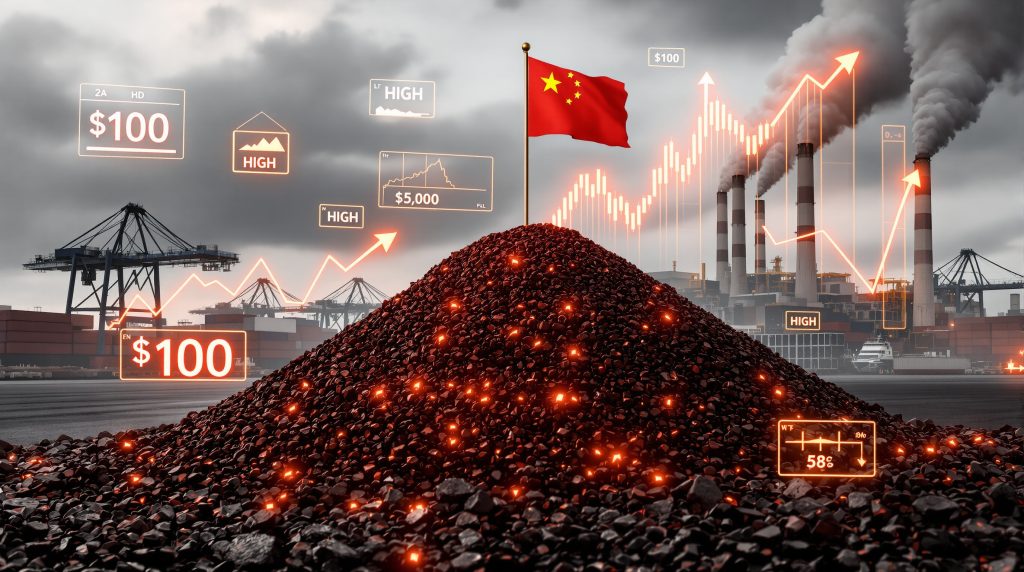What Factors Are Driving Iron Ore Price Volatility?
Iron ore markets face unprecedented turbulence as multiple pressures converge to challenge the commodity's stability. Singapore futures trading at $103.75 per tonne reflects a 1.4% weekly decline, signaling deeper structural issues within the global steel supply chain. The convergence of oversupply conditions, weakening demand fundamentals, and inventory buildups creates a perfect storm for sustained iron ore price pressure through the remainder of 2025.
Chinese Steel Mill Profitability Crisis
Chinese steel producers confront their most challenging operating environment in recent years, with mills sliding back into negative margin territory. The correction in domestic steel prices has eliminated profitability buffers that previously sustained robust iron ore procurement patterns. Steel mills now face the dual challenge of excess production capacity alongside government-imposed output restrictions designed to address environmental concerns and market oversupply.
This profitability squeeze translates directly into reduced purchasing power for raw materials. Mills operating at break-even or loss-making levels naturally curtail their iron ore buying, creating downward demand pressure that reverberates through global markets. Furthermore, the iron ore price trends indicate this pattern may persist through the fourth quarter.
Production overcapacity estimates suggest Chinese steel output exceeds domestic consumption by approximately 15-20%, forcing mills to compete aggressively for export markets while managing elevated inventory levels. However, government production curbs, while aimed at market stabilization, paradoxically contribute to uncertainty as mills struggle to optimize procurement strategies amid shifting output quotas.
Global Supply-Demand Imbalance Intensifies
The fundamental supply-demand equation for iron ore shows clear signs of imbalance, with production expansion significantly outpacing consumption growth across major markets. New supply sources entering the market coincide with weakening demand signals from traditional steel-consuming sectors, creating oversupply conditions that pressure pricing mechanisms.
Inventory accumulation at both mill and port facilities indicates genuine demand weakness rather than temporary seasonal adjustments. Chinese consultancy data from Mysteel reveals substantial increases in iron ore stockpiles, suggesting mills are building strategic reserves while actual consumption patterns lag behind import volumes. In addition, comprehensive iron ore demand insights reveal structural changes affecting long-term consumption patterns.
The emergence of additional supply capacity, particularly from projects previously delayed by market conditions, compounds the oversupply scenario. Mining companies that deferred production during previous downturns now bring capacity online just as demand fundamentals weaken, creating timing mismatches that exacerbate price volatility.
How Are Rising Inventories Affecting Market Dynamics?
Inventory dynamics provide crucial insights into genuine market conditions versus speculative trading patterns. Current stockpile levels at Chinese ports and steel mills exceed typical seasonal averages, indicating structural demand weakness rather than temporary supply disruptions.
Port and Mill Stockpile Analysis
Chinese port inventories show sustained increases despite record-high import volumes in recent months. This apparent contradiction between import strength and consumption patterns suggests mills are building strategic stockpiles while actual steel production faces constraints from profitability pressures and regulatory restrictions.
Regional distribution of excess supply across major trading hubs reveals concentration risks in key markets. Ports in eastern China report particularly elevated inventory levels, reflecting both increased import activity and reduced inland transportation to consuming regions. Consequently, storage capacity constraints at some facilities create logistical bottlenecks that compound pricing pressures.
The distinction between strategic stockpiling and genuine demand becomes critical for price forecasting. Mills accumulating inventory during price weakness may represent temporary demand displacement rather than fundamental consumption growth, suggesting potential future demand gaps as stockpiles normalise.
Import Volume Versus Consumption Patterns
Record-high Chinese iron ore imports in recent months create a disconnect with domestic steel production trends. While import volumes surge, steel mill output faces restrictions from profitability constraints and government-imposed production limits, indicating inventory buildup rather than consumption-driven demand.
Seasonal demand fluctuations typically support iron ore pricing during fourth-quarter periods, but current patterns show deviations from historical trends. Construction sector weakness in China, traditionally a major steel consumer, undermines seasonal support mechanisms that markets typically rely upon for price stability. Moreover, detailed price decline analysis suggests these patterns reflect deeper structural issues.
Port congestion and storage capacity constraints add operational complexities to inventory management strategies. Some facilities report near-maximum storage utilisation, potentially creating forced selling pressures if import flows continue at elevated levels while consumption lags.
What Role Does the $100 Per Tonne Support Level Play?
The $100 per tonne psychological barrier represents more than technical analysis convenience; it embodies market sentiment and fundamental cost structures across the iron ore value chain. Historical trading patterns show this level has provided support during previous downturns, but current market conditions test the durability of this price floor breakdown.
Technical Analysis of Price Floor Breakdown
Trading volume patterns around the $100 support level reveal increased volatility as markets test critical thresholds. Recent trading sessions show elevated volume during price approaches to this level, indicating significant market attention and potential accumulation or distribution activity.
The historical significance of this price point stems from its alignment with marginal production costs for higher-cost mining operations. Should prices breach this support decisively, additional supply rationalisation may occur as uneconomical operations face closure pressures.
Market sentiment shifts become pronounced when critical support levels face sustained pressure. For instance, options markets and futures positioning suggest increased bearish sentiment as traders position for potential support breakdowns, creating self-reinforcing selling pressure.
Fourth Quarter Outlook and Price Projections
Analyst forecasts increasingly point toward continued downside pressure through the fourth quarter, with seasonal demand patterns failing to provide traditional support. Steel market analysis specifically highlights risks to the $100 floor amid weak Chinese fixed-asset investment and deteriorating steel mill profitability.
Seasonal demand patterns historically support iron ore pricing during fourth-quarter construction activity peaks, but current economic indicators suggest deviation from typical trends. Chinese infrastructure spending shows weakness, while real estate sector conditions remain subdued, undermining traditional demand drivers.
Economic indicators across major consuming regions signal continued weakness, with manufacturing sentiment surveys showing contraction in steel-intensive sectors. Global construction activity forecasts for early 2026 provide limited optimism for near-term demand recovery.
How Is New Supply Impacting Long-Term Price Stability?
Emerging supply sources fundamentally alter long-term iron ore market dynamics, with Guinea's Simandou project representing the most significant development in global iron ore supply infrastructure in decades.
Guinea's Simandou Project Market Entry
The Simandou project, recognised as the world's largest undeveloped iron ore deposit, begins initial production phases that will eventually deliver substantial supply increases to global markets. With estimated reserves exceeding 2.4 billion tonnes of high-grade ore, this project represents a paradigm shift in global supply dynamics.
Production capacity projections suggest eventual output reaching 150 million tonnes annually at full development, representing approximately 10% of current global seaborne iron ore trade. Furthermore, the timeline for reaching full operational capacity spans multiple years, but initial production volumes already influence market sentiment and pricing expectations alongside other largest iron ore mines globally.
Quality grades from Simandou deposits exceed 65% iron content, providing competitive advantages over many existing global suppliers. This high-grade ore commands premium pricing but also displaces lower-grade alternatives, potentially reshuffling market share amongst established producers.
Major Producer Response Strategies
Established iron ore producers implement cost reduction initiatives to maintain competitiveness against new supply sources. Rio Tinto, Vale, and BHP Billiton focus on operational efficiency improvements and technology integration to reduce unit production costs.
Production optimisation strategies emphasise higher-grade ore extraction and processing efficiency improvements. Mining companies prioritise projects that maximise value per tonne rather than simply increasing volume, reflecting market conditions that reward quality over quantity.
Strategic partnerships and joint venture developments allow companies to share development costs and risks associated with major projects. These collaborations become particularly important as capital allocation decisions face scrutiny from shareholders demanding improved returns on investment.
What Economic Indicators Signal Continued Pressure?
Broader economic conditions across major steel-consuming regions provide context for iron ore demand forecasting and price trajectory analysis.
Chinese Fixed-Asset Investment Trends
Chinese fixed-asset investment patterns show concerning weaknesses in steel-intensive sectors, particularly construction and infrastructure development. Government spending priorities shift toward technology and services sectors, reducing relative emphasis on traditional heavy industry development.
Construction sector indicators reveal persistent weakness in both residential and commercial development. Property market conditions remain subdued despite government stimulus efforts, limiting steel demand from traditional building construction activity.
Infrastructure spending patterns reflect government policy adjustments that prioritise efficiency over volume growth. While total infrastructure investment continues, projects increasingly emphasise maintenance and upgrades rather than new large-scale steel-intensive developments. Additionally, the tariffs impact on iron ore markets adds complexity to global trade flows.
Global Steel Production Metrics
Regional steel production capacity utilisation rates vary significantly, with many producers operating below optimal efficiency levels. European and North American mills face particular challenges from energy costs and environmental regulations that increase operational expenses.
Export-import balance shifts affect regional pricing mechanisms as producers seek alternative markets for excess production. Traditional trade flows face disruption from geopolitical tensions and changing competitive dynamics amongst major producing regions.
Manufacturing sector health indicators across key markets show mixed signals, with automotive and machinery production facing headwinds while some infrastructure-related sectors maintain stability. These varied conditions create complex demand patterns that complicate iron ore consumption forecasting.
How Are Currency Fluctuations Affecting Iron Ore Pricing?
Exchange rate movements significantly influence iron ore pricing dynamics, particularly the relationship between Chinese yuan and US dollar valuations that dominate international commodity trading.
Yuan-Dollar Exchange Rate Impact
Currency strength variations directly affect purchasing power in key iron ore markets, with yuan appreciation improving Chinese buyers' ability to purchase dollar-denominated commodities, while depreciation creates affordability constraints.
Hedging strategies employed by major buyers and sellers attempt to manage currency risk, but these financial instruments add complexity and cost to trading relationships. Market participants increasingly factor currency volatility into pricing negotiations and contract structures.
Regional price differentials emerge based on currency movements, creating arbitrage opportunities and supply flow adjustments. Australian and Brazilian producers particularly benefit from favourable exchange rates that improve competitiveness in Asian markets.
Commodity Index Performance Correlation
Iron ore's correlation with broader commodity indices affects institutional investor positioning and fund flows that influence pricing beyond fundamental supply-demand factors. Commodity index funds create additional volatility through systematic buying and selling programmes.
Base metals performance influences iron ore sentiment through sector rotation effects and industrial demand correlations. For instance, copper, aluminium, and zinc price movements often precede iron ore adjustments as markets assess industrial activity levels.
Energy price impacts on mining and transportation costs create operational cost pressures that affect marginal supply economics. Rising fuel costs particularly impact seaborne iron ore trade, where shipping represents significant cost components.
What Are the Implications for Mining Companies?
Mining companies face operational and strategic challenges as market conditions test business model resilience and force adaptation to changing competitive landscapes.
Operational Cost Management Strategies
Break-even analysis for major iron ore operations reveals vulnerability thresholds as prices approach marginal cost levels. Companies with higher-cost operations face particular pressure to improve efficiency or consider production curtailments.
Capital expenditure deferrals and project postponements become common responses to market uncertainty. Mining companies prioritise cash conservation and delay expansion projects that require significant upfront investment amid uncertain price recovery timelines.
Workforce optimisation and automation investments aim to reduce operational costs whilst maintaining production capacity. Technology integration initiatives focus on productivity improvements that provide sustainable competitive advantages.
Market Share Competition Intensifies
Quality premium strategies versus volume-based approaches create strategic choices for mining companies. Producers with high-grade ore resources emphasise quality differentials, while others compete primarily on cost and volume efficiency.
Customer relationship management becomes crucial during price volatility periods as mills evaluate supplier reliability and contract terms. However, long-term partnerships provide stability but may limit pricing flexibility during market adjustments.
Contract negotiation strategies adapt to market conditions through more flexible pricing mechanisms and shorter commitment periods. Both buyers and sellers seek arrangements that provide protection against extreme price movements whilst maintaining supply security.
When Might Iron Ore Prices Find Support?
Recovery scenarios depend on multiple variables converging to restore supply-demand balance and rebuild market confidence in sustainable pricing levels.
Demand Recovery Scenarios
Chinese economic stimulus potential represents the most significant variable for iron ore demand recovery. Government infrastructure spending increases or construction sector support measures could rapidly shift demand dynamics, though policy implementation remains uncertain.
Global construction activity forecasts for 2025-2026 show modest growth expectations, but timing and magnitude depend on broader economic conditions and regional policy responses. Infrastructure modernisation needs in developed countries provide potential demand support.
Green steel transition initiatives create new demand patterns as steel producers invest in cleaner production technologies. While these developments support long-term demand growth, implementation timelines extend over multiple years rather than providing immediate price support.
Supply-Side Adjustment Expectations
High-cost producer shutdown thresholds become relevant if prices remain below marginal cost levels for extended periods. Operations with cash costs exceeding current pricing face difficult decisions about continued production versus temporary closures.
Maintenance and expansion project timing considerations allow producers some flexibility in managing supply responses to market conditions. Consequently, delayed maintenance can temporarily reduce capacity, while expansion deferrals limit future supply growth.
Geopolitical factors affecting supply chain stability introduce uncertainty elements that markets monitor closely. Trade relationship changes, regulatory adjustments, and infrastructure developments in key producing regions influence long-term supply reliability assessments.
Key Market Data and Statistics Summary
| Metric | Current Level | Trend | Impact |
|---|---|---|---|
| Singapore Futures Price | $103.75/tonne | -1.4% weekly | Bearish pressure continuing |
| Chinese Mill Inventories | Above seasonal average | Rising consistently | Demand weakness indicator |
| Import Volumes | Record highs recorded | Increasing despite weak consumption | Oversupply conditions |
| Steel Mill Margins | Negative territory | Declining profitability | Reduced purchasing power |
| Support Level Risk | $100/tonne threshold | Under sustained pressure | Critical technical breakdown risk |
| Simandou Project Impact | Initial production phases | New supply entering market | Long-term pricing pressure |
"The convergence of elevated Chinese inventories, record import levels amid weak steel mill profitability, and new supply from major projects creates a challenging environment for iron ore price pressure stability through the fourth quarter of 2025."
Investment and Trading Considerations
Current market conditions create both risks and opportunities for investors and industry participants navigating volatile iron ore pricing environments.
Risk Management Strategies
Volatility trading opportunities emerge during significant price movements, particularly around technical support and resistance levels. Options strategies and futures positioning allow traders to capitalise on price swings whilst managing downside exposure through defined risk parameters.
Hedging approaches for industry participants become essential as price volatility threatens operational planning and financial stability. Steel mills and mining companies increasingly utilise financial instruments to manage price risk and ensure operational continuity.
Portfolio diversification across commodity sectors helps investors manage iron ore-specific risks whilst maintaining exposure to industrial metals themes. Base metals, precious metals, and energy commodities provide alternative investment avenues with different risk-return profiles.
Long-Term Value Assessment
Fundamental analysis versus technical trading signals requires careful evaluation of underlying supply-demand factors against short-term price movements. Long-term investors focus on structural trends whilst traders emphasise technical patterns and momentum indicators.
Quality premium sustainability in oversupplied markets becomes questionable as buyers prioritise cost savings over ore quality differentials. High-grade ore producers must demonstrate clear value propositions to maintain premium pricing during market stress.
Strategic positioning for eventual market recovery requires patience and careful capital allocation as recovery timing remains uncertain. However, investors with longer investment horizons may find opportunities in oversold conditions, while shorter-term participants focus on risk management and capital preservation.
Disclaimer: This analysis is based on current market conditions and publicly available information as of October 2025. Commodity markets involve significant risks, and past performance does not guarantee future results. Investors should conduct their own research and consider consulting financial advisors before making investment decisions. Price forecasts and market projections are speculative and subject to change based on evolving economic, political, and market conditions.
Ready to Capitalise on Iron Ore Market Volatility?
Discovery Alert's proprietary Discovery IQ model delivers real-time alerts on significant iron ore and mineral discoveries, instantly empowering subscribers to identify actionable opportunities ahead of the broader market during periods of commodity volatility. Begin your 30-day free trial at Discovery Alert today and secure your market-leading advantage in navigating complex commodity cycles.




